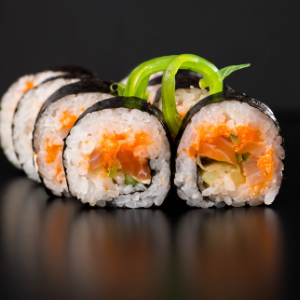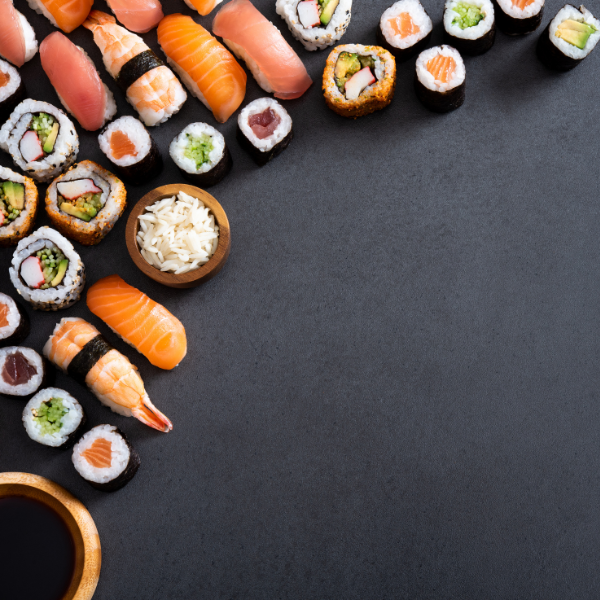Sushi is one of the most popular dishes that can be found in restaurants all over the world. But what many people don’t know is that there are different types of sushi, each with its own unique flavor and texture. There are flavors to fit all kinds of taste buds as well as a pleasing aesthetic. Want to open your own sushi restaurant or want to add sushi options to your menu? Well, you’ve come to the right place! In this blog post, we will explore the different types of sushi.
What Is Sushi?
Sushi is a Japanese dish that is made with medium-grained rice that has been cooked in vinegar, usually added with raw or cooked fish. According to Dictionary.com, the word “sushi” actually refers to the rice, not the fish as many people believe. Sushi can be made with a variety of different ingredients, including vegetables, seafood, and meats. However, not all sushi is rolled into perfect small or medium bite sizes, it can have multiple different forms depending on the style.
The Different Types of Sushi
What makes sushi so popular around the world is that there are many varieties to choose from. There are cooked ones for those who can’t eat raw fish, spicy or not spicy, even full vegetable rolls for vegans or vegetarians. Below we discuss the different types of sushi.
Nigiri Sushi
Nigiri sushi is a type of sushi that is made by shaping rice into an oval-shaped mount and topping it with sliced fish (usually raw) or other seafood. Nigiri sushi means “to grap or to grip,”which correlates with the process it takes to make nigiri, since the rice is molded by hand and the slice of fish or seafood is pressed on top. Some of the types of fish used for nigiri include tuna, salmon, yellowtail, and albacore.

Types Of Nigiri Sushi:
- Sake: Topped with raw salmon, simple and clean texture. Ideal for new sushi eaters.
- Ebi: Butterfly shrimp that has been skewered, boiled, and chilled in ice. Marinated in ginger juice for firm texture and extra flavor.
- Unagi: Freshwater eel that is cooked. Soft texture and mild in flavor. Great for people who prefer not to consume raw fish..
- Hamachi: Japanese amberjack that is sliced, sometimes known as yellow tuna. Soft in texture and light in flavor.
- Uni: Topped with sea urchin gonads that contain a creamy, delicate, and smooth texture. It has a rich sea salty flavor.
- Tako: Sliced octopus with a mild sweet and sour flavor. Chewy texture and can be eaten in one bite.
- Tamago: Contains sliced egg omelet. Has a clean finish and is sweet in flavor. Perfect for vegetarians.
Chirashi Sushi
Chirashi sushi is a lesser-known type of sushi. Chirashi actually means “scattered” in Japanese, which explains the way toppings are placed on the sushi rice in a bowl. Usual toppings for chirashi sushi can include raw fish, eggs, or nori. However, the overall appearance of this sushi dish is very clean.
Types of Chirashi:
- Kanto-style chirashi: Toppings are piled over rice. Features nine different toppings that can include raw salmon, tuna, or scallops.
Kansai-style chirashi: Known as five-ingredient sushi, this dish contains five toppings spread out over rice. Toppings can include thin omelets, fish roe, or even lotus root.

Maki Sushi
Maki sushi is made by rolling rice and fish inside of a seaweed wrapper. It is rolled into thin tubes, creating bite-sized pieces. All sushi rolls with fillings on the inside and seaweed wrapper on the outside are considered maki sushi.
Types Of Maki Sushi:
- Hosomaki (small): The smallest type of maki sushi and very easy to eat due to its size. It has one filling, typically cucumber or graded tuna.
- Nakamaki (medium): Similar to hosomaki but slightly bigger. Includes 2 to 3 different ingredients in the middle.
- Futomaki (large): Thick maki sushi roll that contains various ingredients with rice. Includes shrimp, crab, eel, egg, and even tofu.

Uramaki Sushi
Known as an “inside-out” roll, uramaki sushi was created in Los Angeles by a sushi chef, the history explained by Shogun Japanese Steakhouse. This sushi chef noticed that Americans did not like the traditional maki sushi with the seaweed wrapper on the outside, which led him to develop this inside-out delicacy. In fact, most of the popular rolls people think of when they think of sushi are actually uramaki sushi.
Types Of Uramaki Sushi:
- Dragon Roll: Contains a filling of cucumber, grilled eel, and shrimp tempura with sliced avocado on top that creates a dragon scale allusion.
- Rainbow Roll: A colorful creation, a rainbow roll is filled with avocado, cucumber, and raw fish, usually tuna, salmon, or yellowtail.
- California Roll: A popular choice, this roll contains crab meat or imitation crab meat, avocado, and cucumber.
- Spicy Tuna Roll: For spicy lovers, this roll is filled with raw chopped tuna mixed with sriracha and sesame oil. Spicy mayo is added on top.

Temaki Sushi
Temaki sushi is made by rolling rice and different ingredients inside of a cone-shaped seaweed wrapper. Interestingly, this hand roll has no special technique to produce which makes it easy for anyone to do. It is supposed to be eaten by hand and is imperfect.
Typical Ingredients For Temaki:
- Salmon
- Spicy tuna
- Yellow tail
- Uni
- Scallops
- Avocados
- Cucumbers
- Shiso leaves

Sashimi Vs Sushi
Sashimi is not considered sushi, since it contains no rice. A vital asset to Japanese cuisine, sashimi is typically thinly sliced raw fish or meat. Sashimi tends to usually be more fish and seafood than meat. In addition, sashimi can also be cooked as well. There aren’t many toppings or fillings in sashimi because the point is to accentuate the flavor of the fish itself.
Types Of Sashimi:
- Sake: Raw sliced salmon
- Uni: Sea urchin
- Ebi: Cooked shrimp
- Ahi: Raw tuna
- Tako: Raw or poached octopus
- Hamachi: Raw Japanese Amberjack

How to Choose the Right Type of Sushi For Your Menu
When choosing the right type of sushi for your menu, it is important to consider your customers’ personal preferences. You’ll have many factors you’ll have to consider: spicy versus non spicy, raw or cooked, etc. Pay attention to customer data and feedback to understand what will best fit your guests’ taste buds..
If your customer is a fan of rice, then sushi rolls or nigiri sushi may be the right choice. If they love fish, then sashimi may be the perfect fit. And if they are huge seafood lovers, then chirashi sushi is definitely worth a try. Offering a variety of options of each type of sushi will give your patrons the opportunity to try the one that works for them.
An Option For Everyone
Sushi is a delicious and popular dish that comes in many different forms. With so many options to choose from, it can be hard to know which type of sushi is right for your customers. With this guide, you’ll be able to understand all the different types of sushi and find your favorite options to add to your menu and appeal to your guests. Stay tuned for more restaurant related guides from Jamil Bouchareb, and food experts.



